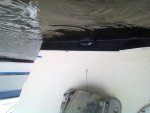OK so let's assume for the moment that you aren't taking on water, and that you don't know if this low-scuppers / not-draining issue is "brand new" or not. Maybe this is the first time you've hosed the deck while
on the water?
(Also, did you note whether this water on deck did drain once you went up on plane? That at least would mean the scuppers
are working)
I can't find that the "Fisherman" model existed in 1975, but I'm gonna assume your hull is something like an 18' CC or runabout-type, with a listed hull dry weight somewhere around 1400-1500lbs, kinda like the Adventurer or Challenger (150hp max OB) models from 1975:
http://www.gradywhite.com/media/2822/1975.pdf
Some quick checking on NADA says that Evinrude 115-135hp OB's of that era--which is what I assume it originally had--weigh in around 270lbs. Your 2003 Yamaha 130 txrb clocks in at around 360lbs. That's 90# more weight than the designers expected, smack-dab on top of your transom, making you aft-heavy.
(And do I see a kicker bracket in your photo? Is there a kicker on it? That's even more transom weight the designers didn't design for.)
I'm having a very similar issue with my 2000 17' CC (1200lb listed dry hull weight)...the 2012 125hp Mercury Optimax on there now is about 60# heavier than the 2000 90hp or 115hp Evinrude it had originally, which put my scuppers kissing the waterline too (especially with my fat butt fishing off the rear deck), leading to what I call "wet deck syndrome." I am attempting to correct for that weight imbalance by moving the starting battery from the boat designer's original, "brain-challenged" location UNDERDECK IN THE D**MNED BILGE to above-deck under the console, forward of the center-of-gravity...and also adding a second battery in the same location. I'm only halfway done with that project and it has already helped greatly. I may even also have to put some 50# of ballast up in the forward anchor locker before I'm done. I'm expecting all this to help not just with the wet deck / scupper issue, but also to reduce bow-rise when I punch it. I wonder if some weight re-balancing may be all you need. How's the boat performing otherwise?
(And do you ever get a following wave wash over your transom notch if you cut power / come to a stop too abruptly? I used to!)
I have noticed that newer hulls in this size range, say mid-2000's and up, seem to be correcting for today's heavier outboards by going to Euro-style transoms with some set-back and a full transom (or transom well). I've seen people correct for this in older hulls with newer/bigger OB's by using set-back plates, bolt-on pods/extensions (some with very nice built-in swim platforms), home-built transom well/shroud thingies, etc. Not sure yet whether I want to consider any of that (well,
maybe a setback plate with vertical trim, especially since I spend so much time in thick kelp...

), or just wait 5-10 years and find a 5-10 year newer hull for my motor.
In poking around on this and other forums, it seems I'm (we're?) not alone in this "wet deck" issue, it seems to be most prevalent on older 17-19' OB-powered hulls that are being re-powered to heavier motors (and smaller IO-to-OB conversions!). I predict this topic will become even more visited in coming years as we're kind of approaching that 20-year "time to repower" threshold for a lot of those pre-mid-2000's hulls out there.
(Scott Danforth is right though; you should weigh your rig--or whatever it takes, poking, prodding, drilling test holes--to see if you're not just overall-heavy from soaked foam, wet wood, etc. Boat seem structurally sound?)




















